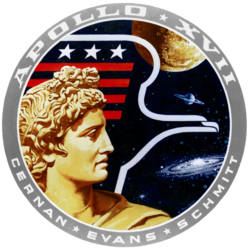Eugene Cernan
| Eugene Cernan | |
 | |
| NASA-astronaut | |
|---|---|
| Född | 14 mars 1934 Chicago, Illinois, USA |
| Död | 16 januari 2017 (82 år) Houston, Texas, USA |
| Tid i rymden | 23 dagar, 14 timmar, 15 minuter[1] |
| Urvalsgrupp | Astronautgrupp 3 den 17 oktober 1963 |
| Antal rymdpromenader | 1 st |
| Rymdpromenadtid | 2 timmar, 9 minuter |
| Antal månpromenader | 3 st |
| Månpromenadtid | 22 timmar, 5 minuter |
| Uppdrag | Gemini 9A, Apollo 10, Apollo 17 |
| Uppdragsemblem | |
Eugene Andrew "Gene" Cernan, född 14 mars 1934 i Chicago, Illinois, död 16 januari 2017 i Houston i Texas,[2] var en amerikansk astronaut uttagen i astronautgrupp 3 den 17 oktober 1963.
Cernan var i rymden tre gånger. Två av rymdfärderna gick mot månen. Under Apollo 10 testades månlandaren (utan att landa på månens yta) inför den första månlandningen med Apollo 11. Under Apollo 17 landade Cernan på månen och blev den elfte mannen på månen och var sist in i månlandaren efter den tredje och sista månpromenaden under Apollo 17. Cernan, John Young och Jim Lovell är de enda tre personer som har rest till månen två gånger. Av dessa är det bara Cernan och Young som gått på månen.
Eftermäle
Orbital ATK:s rymdfarkost Cygnus CRS OA-8E var uppkallad efter honom.
Asteroiden 12790 Cernan är uppkallad efter honom.[3]
Rymdfärder
Rymdfärdsstatistik
| Färd | Datum (UTC) | Tid | EVA | LEVA |
|---|---|---|---|---|
| Gemini 9A | 3 - 6 juni 1966 | 72:20:50 | 02:09:00 | 00:00:00 |
| Apollo 10 | 18 - 26 maj 1969 | 192:03:22 | 00:00:00 | 00:00:00 |
| Apollo 17 | 7 - 19 december 1972 | 301:51:58 | 00:00:00 | 22:05:00 |
| Totalt | 566:15:10 | 02:09:00 | 22:05:00 | |
Källor
”Biographical Data” (på engelska) (PDF). NASA. januari 2017. https://www.nasa.gov/wp-content/uploads/2023/09/cernan_eugene_a._deceased_pdf_75_kb_.pdf. Läst 22 juni 2024.
- ^ ”Spacefacts” (på engelska). Spacefacts. http://www.spacefacts.de/bios/astronauts/english/Cernan_Eugene.htm. Läst 8 februari 2018.
- ^ ”Gene Cernan, Last Astronaut to Walk on the Moon, Dies at 82” (på engelska). ABC News. 16 januari 2017. http://abcnews.go.com/US/wireStory/gene-cernan-astronaut-moon-dies-82-44814436. Läst 17 januari 2017.
- ^ ”Minor Planet Center 12790 Cernan” (på engelska). Minor Planet Center. https://www.minorplanetcenter.net/db_search/show_object?object_id=12790. Läst 22 februari 2023.
|
Media som används på denna webbplats
Gemini 9 Patch
- Ensignia of the GT-IX Space Flight. Roman numeral indicates ninth flight in the Gemini series. Two spacecraft symbolize rendezvous and docking of Gemini with Agena. Astronaut and umbilical tether line denotes planned Extravehicular Activity EVA.
S71-51308 (21 Sept. 1971) --- Astronaut Eugene A. Cernan
Logo Apollo 10
Emblem of the Apollo 10 lunar orbit mission. The prime crew of Apollo 10 is astronauts Thomas P. Stafford, commander; John W. Young, command module pilot; and Eugene A. Cernan, lunar module pilot.
This is the official emblem of the Apollo 17 lunar landing mission which was flown by astronauts Eugene A. Cernan, Ronald E. Evans and Harrison H. Schmitt.
- The insignia is dominated by the image of Apollo, the Greek sun god. Suspended in space behind the head of Apollo is an American eagle of contemporary design, the red bars of the eagle's wing represent the bars in the United States flag; the three white stars symbolize the three astronaut crewmen. The background is deep blue space and within it are the moon, the planet Saturn and a spiral galaxy or nebula. The moon is partially overlaid by the eagle's wing suggesting that this is a celestial body that man has visited and in that sense conquered. The thrust of the eagle and the gaze of Apollo to the right and toward Saturn and the galaxy is meant to imply that man's goals in space will someday include the planets and perhaps the stars. The colors of the emblem are red, white and blue, the colors of our flag; with the addition of gold, to symbolize the golden age of space flight that will begin with this Apollo 17 lunar landing. The Apollo image used in this emblem was the famous Apollo of Belvedere sculpture now in the Vatican Gallery in Rome. This emblem was designed by artist Robert T. McCall in collaboration with the astronauts.



